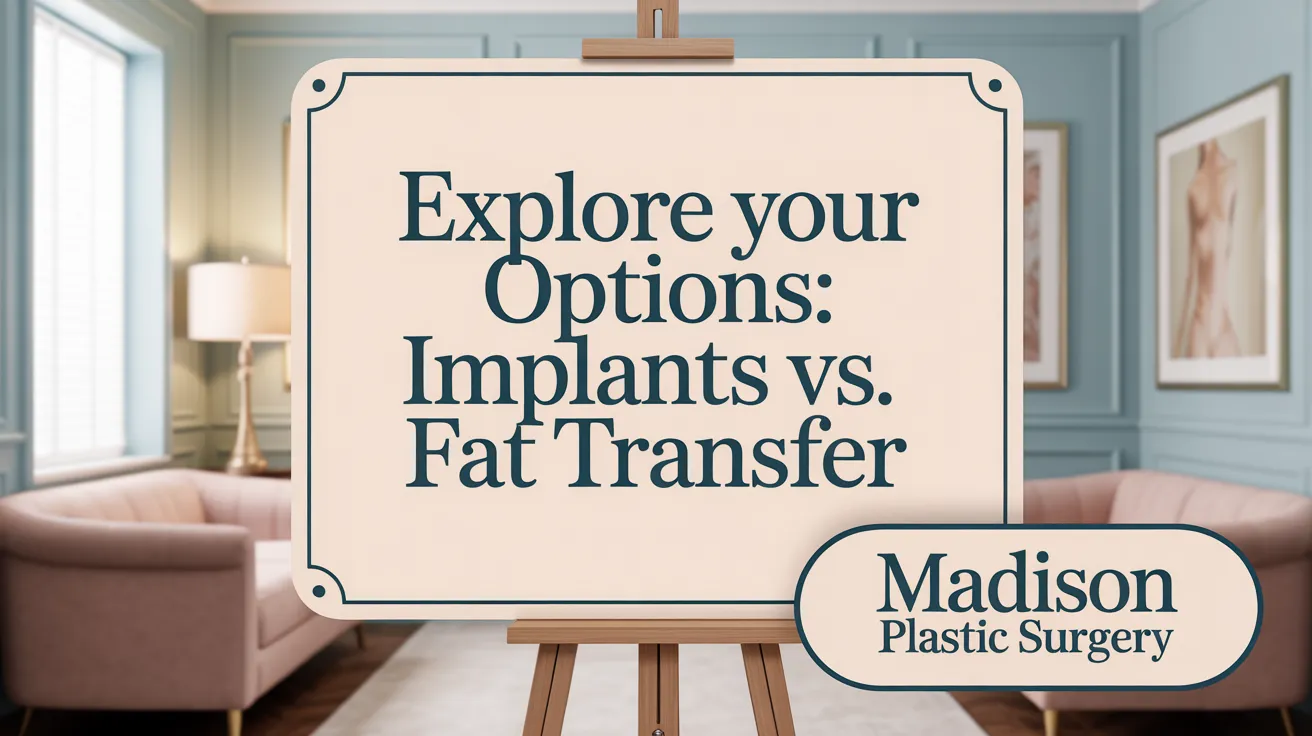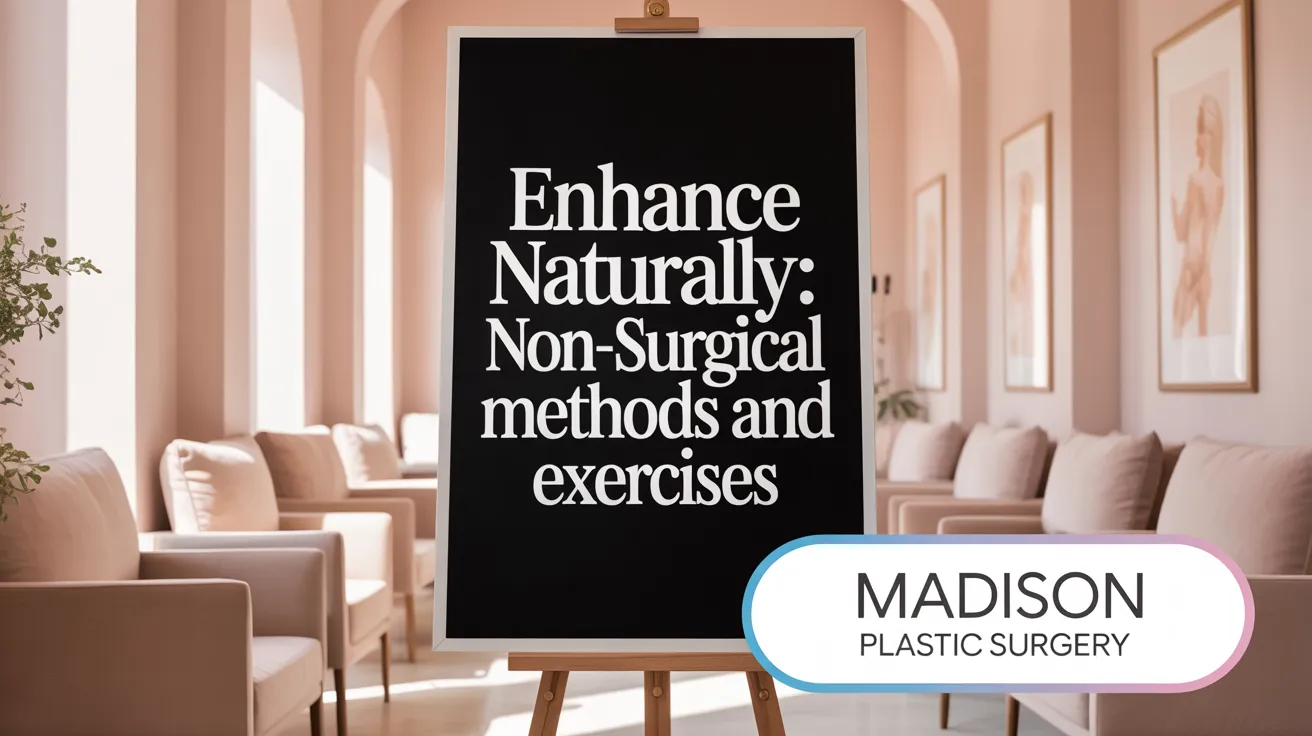Navigating the Path to Natural Breast Enhancement
Breast enhancement has evolved significantly with advances in surgical techniques and implant technology, enabling women to achieve fuller breasts that appear natural and harmonious with their body shapes. Whether considering implants or fat transfer, understanding the myriad of options, potential risks, and personalized factors is critical in making an informed choice. This article explores key considerations and methods for selecting natural-looking breast enhancements, ensuring confidence and satisfaction in the results.
Understanding Breast Enhancement Options: Implants and Fat Transfer

What are the main types of breast enhancement methods?
Breast enhancement is primarily achieved through two approaches: breast implants and fat transfer.
-
Breast Implants: These come in three main types:
- Saline implants: Filled with sterile saltwater, often inserted empty and filled during surgery.
- Silicone implants: Filled with silicone gel, which closely mimics the softness and movement of natural breast tissue.
- Gummy bear implants: A form-stable type of silicone implant made of cohesive gel that holds shape even if the shell breaks, often with a teardrop shape for natural contour.
-
Fat Transfer Augmentation: This technique uses the patient’s own fat, harvested via liposuction from areas like the abdomen or thighs, and reinjected into the breasts. It offers subtle volume enhancement with a natural feel and no implants.
What are the advantages and limitations of fat transfer compared to implants?
Advantages of fat transfer:
- Produces a natural look and feel without foreign material (natural breast enhancement methods).
- Leaves no scars on the breasts.
- Provides the added benefit of contouring donor areas.
Limitations of fat transfer:
- Typically achieved volume increase is modest, usually about one cup size.
- Fat survival is unpredictable; multiple procedures may be necessary to reach desired volume.
- Does not significantly lift or reshape the breast; unsuitable for correcting sagging.
Customizing based on patient goals and anatomy
Choosing between implants and fat transfer depends on the patient's anatomy, desired size increase, and personal preferences. Implants allow for larger and more predictable volume enhancement and modification of breast shape (personalized breast augmentation approach). Fat transfer is ideal for patients seeking natural subtle enhancements and who have sufficient donor fat (benefits of fat transfer augmentation).
An experienced surgeon carefully evaluates body proportions, breast tissue quality, and lifestyle goals to recommend the best approach, ensuring a personalized plan for natural-looking results (consulting experienced surgeons).
Choosing the Right Implant Material and Shape for Natural Results
Silicone vs. Saline Implants: Feel and Appearance Differences
Silicone implants are widely regarded as offering the most natural look and feel among breast implant materials. Their cohesive silicone gel closely mimics the softness and gentle movement of natural breast tissue. In contrast, saline implants, which are filled with sterile saltwater, tend to be firmer and can sometimes appear more rounded or less natural, especially in women with thin breast tissue.
Gummy Bear Implants and Cohesive Silicone Gel Benefits
Gummy bear implants, a subtype of silicone implants filled with a highly cohesive gel, are designed to maintain their shape even if the implant shell is compromised. This form-stable quality helps provide a natural teardrop shape that better resembles the contour of a natural breast. Additionally, gummy bear implants tend to reduce issues like rippling and provide durability over time.
Round vs. Teardrop (Anatomical) Implant Shapes
The shape of the implant significantly affects breast contour and natural appearance. Teardrop or anatomical implants feature a gentle slope with more fullness at the bottom, emulating the natural shape of breasts. This usually results in a more natural silhouette.
Round implants, on the other hand, create a fuller upper breast area, offering a more enhanced look. While sometimes less natural in appearance, careful sizing and placement can still achieve subtle and natural results (Breast augmentation options).
How Implant Shape Affects Natural Breast Contour
The implant's shape dictates how the breast projects and slopes from the chest wall. Teardrop implants offer a gradual, realistic slope, ideal for those prioritizing a soft, natural contour. Round implants provide more uniform projection and can emphasize cleavage but may risk appearing more artificial if not sized properly.
Patient Body Type and Implant Selection
Choosing the implant shape and material must also consider the patient’s body frame and anatomy. Smaller, teardrop-shaped gummy bear implants are often the best choice for petite frames or women with less natural breast tissue, ensuring a proportional and natural look. Larger or round implants may suit patients seeking more volume but require expert surgical planning to maintain natural aesthetics (Choosing the right breast implant).
| Implant Material | Characteristics | Natural Look and Feel |
|---|---|---|
| Silicone Gel | Soft, pliable, mimics natural tissue | High (Benefits of Silicone Implants) |
| Saline | Firmer, filled after insertion | Moderate, may ripple in thin tissue (Saline vs Silicone Implants) |
| Gummy Bear (Cohesive) | Form-stable, maintains shape if shell ruptured | Very high, natural teardrop contour (Gummy Bear Implants Benefits) |
| Implant Shape | Description | Effect on Appearance |
|---|---|---|
| Teardrop (Anatomical) | Gradual slope, natural breast shape | Most natural contour (Implant shape effects |
| Round | Fuller upper pole, more projection | Fuller look, can be natural if sized (Breast augmentation options |
Selecting the right combination of implant material, shape, and size tailored to individual anatomy and goals is essential for achieving natural-looking breast augmentation results.
Importance of Implant Size, Profile, and Placement in Achieving Natural Aesthetics
How does implant size affect natural appearance?
Selecting an implant size that matches your body frame is vital for a natural and proportionate look. Typically, implants sized between 300cc and 500cc, equating to roughly a two-cup size increase, yield the most natural results. Choosing implants larger than this range can result in a disproportionate appearance, physical discomfort, and even accelerate breast sagging over time. Thus, moderation tailored to individual body structure ensures a balanced and realistic enhancement.
Profile variations: low, moderate, high projection
Implant profile defines how far the breast projects from the chest wall. Low profile implants have a wider base with subtle projection, moderate profile offers a balanced shape and projection, while high profile implants create the most forward projection. Moderate profile implants often provide the most natural-looking breast shape for many body types by offering a pleasing yet subtle fullness without exaggeration.
What role does implant placement play in natural-looking augmentation?
Implant placement significantly influences breast shape and feel. Submuscular placement, where the implant sits beneath the chest muscle, is commonly preferred for a natural contour. This method provides extra soft tissue coverage, particularly beneficial for thinner individuals, resulting in smoother transitions and minimizing visible implant edges or rippling.
Alternatively, subglandular placement positions the implant just beneath the breast tissue and above the muscle. This generally allows for a softer feel and quicker recovery. However, in some patients, it may cause more noticeable implant edges, potentially affecting the natural appearance. The choice between these placements depends on natural breast tissue, body type, and aesthetic goals.
How placement affects breast shape and feel
Placement directly impacts not only appearance but also the tactile sensation of the augmented breast. Submuscular implants tend to feel more like natural breast tissue as the muscle provides cushioning. Subglandular implants may feel firmer and can create a rounder shape. Surgeons tailor placement to each patient to maximize natural aesthetics and comfort.
By carefully considering implant size, profile, and placement options in consultation with a qualified surgeon, patients can achieve natural-looking breast augmentation results that harmonize with their body and lifestyle.
The Crucial Role of Surgeon Expertise and Customization

Why is surgeon expertise vital in natural-looking breast augmentation?
Choosing a board-certified plastic surgeon with experience is essential for achieving natural-looking breast augmentation results. A skilled surgeon can tailor the procedure to your unique anatomy, lifestyle, and aesthetic goals. They meticulously select implant type, size, and placement to ensure the outcome looks harmonious with your body frame. Expert surgeons adeptly use techniques that minimize complications like capsular contracture, implant malposition, and unnatural breast shapes.
What tools aid in implant selection and visualization?
Advanced tools such as 3D imaging technology and implant sizing devices are invaluable during preoperative planning. They allow you to preview how different implant sizes, shapes, and profiles will look on your body before surgery. This visual aid supports informed decision-making and helps establish realistic expectations, reducing the risk of dissatisfaction post-surgery.
Personalized plans matching patient anatomy and goals
A customized surgical plan considers your chest dimensions, skin quality, and personal preferences, balancing implant features to enhance natural contours. This individualized approach ensures the breast augmentation complements your body proportions, producing subtle, natural results rather than an artificial look.
Consultation importance for realistic expectations
During thorough consultations, the surgeon discusses all options, risks, and anticipated outcomes, ensuring you understand what to expect. This dialogue ensures alignment between your aesthetic desires and achievable surgical results, setting the stage for a successful augmentation journey. See more about the importance of consulting experienced surgeons and having free breast implant consultations.
Fat Transfer: A Natural-Looking Alternative with Unique Considerations
How does fat transfer breast augmentation work and who is a good candidate?
Fat transfer breast augmentation involves a two-step surgical process. First, fat is carefully harvested via liposuction for fat removal from areas with excess fat such as the abdomen, thighs, or flanks. This fat is then meticulously processed to enhance its viability before being strategically injected into the breasts. This technique allows for a natural enhancement in breast size and shape.
Ideal candidates for fat transfer are women seeking modest volume increases—typically around one cup size—or those aiming to correct mild asymmetry. It is also favored by patients desiring a natural look without the use of synthetic implants. Since fat transfer uses the patient’s own tissue, it avoids the introduction of foreign materials and associated implant complications. Learn more about fat transfer breast augmentation.
What are the advantages and challenges of fat transfer?
Advantages:
- Provides a natural feel and appearance closely resembling native breast tissue.
- Leaves no scars on the breasts, enhancing aesthetic outcomes.
- Offers simultaneous body contouring by removing fat from donor sites.
- Eliminates risks associated with breast implants such as capsular contracture or implant rupture.
Challenges and Limitations:
- Fat graft survival is unpredictable, and some resorption occurs, which may require multiple treatment sessions.
- The volume increase is limited, typically not exceeding a one-cup size enhancement.
- Transferred fat can lead to microcalcifications or cysts, potentially complicating future mammogram interpretations.
- Fat transfer cannot correct breast sagging or significantly enhance breast shape; patients with ptosis may require a breast lift in addition.
While fat transfer offers a natural-looking breast enhancement with dual benefits for body contouring, patients should consider these factors and consult experienced surgeons to align expectations and devise individualized plans.
Understanding Risks, Complications, and Long-Term Considerations

What are the most common risks and complications of breast implants?
Breast implants carry several common risks and complications that patients should be aware of. Capsular contracture, the hardening of tissue around the implant, affects about 10% of patients and can cause discomfort and visible distortion, often requiring revision surgery. Implant rupture is another concern; saline implant leaks result in visible flattening, while silicone ruptures may be silent and require MRI for detection. Rippling or wrinkling of the implant surface can occur, especially with saline implants or in women with thin tissue, creating a less natural breast appearance. Importantly, breast implants are not lifetime devices; on average, they last between 10 to 20 years, meaning revision surgeries or replacements may be needed over time.
What is Breast Implant-Associated Anaplastic Large Cell Lymphoma (BIA-ALCL)?
BIA-ALCL is a rare type of lymphoma linked predominantly to textured breast implants. Though very uncommon, it is a serious condition that typically arises from the scar capsule surrounding implants. Treatment usually involves implant removal and capsulectomy. The FDA has restricted sales of textured implants due to this risk, and smooth-surfaced implants are now more commonly used to reduce incidence.
How do implants affect breastfeeding and cancer screening?
Most women with breast implants can successfully breastfeed after surgery, particularly if implants are placed beneath the chest muscle (submuscular placement, which tends to preserve milk ducts and glandular tissue. However, some incision types and placements may affect breastfeeding ability more significantly. Regarding cancer screening, breast implants can complicate mammogram imaging because implants can obscure breast tissue. Specialized imaging techniques, such as implant displacement views, ultrasounds, or MRI scans (especially for silicone implants), are recommended to ensure accurate screening and to monitor for implant rupture or abnormalities.
Implant lifespan and the need for revision surgeries
Since breast implants are not permanent, many patients will require replacement or removal surgeries within 10 to 20 years. Factors such as capsular contracture, implant rupture, changes in breast shape due to aging or weight fluctuation, and patient preference can lead to revision. Regular follow-up with a board-certified plastic surgeon is essential to monitor implant integrity and manage any complications early.
Maintaining awareness of potential risks and long-term considerations enables patients to make informed decisions and achieve satisfying, safe outcomes with breast augmentation.
Non-Surgical and Adjunctive Approaches to Enhancing Breast Appearance

Are there effective non-surgical methods to increase breast size?
Non-surgical methods do not significantly or permanently increase breast size. Supplements and creams marketed for breast enlargement generally lack scientific support and FDA approval. While chest exercises such as push-ups, dumbbell presses, and pec flies strengthen the muscles beneath the breasts, they do not enlarge the breast tissue itself but can enhance overall chest contour and firmness (Chest exercises for stronger pectoral muscles). Temporary solutions like padded or push-up bras offer an immediate visual boost by enhancing shape but do not affect actual breast size (Enhancing bras with padding).
What nonsurgical procedures can improve breast aesthetics?
Several minimally invasive techniques can help improve breast appearance by tightening skin and stimulating collagen:
- Aptos threading: Involves inserting barbed threads to lift and support breast tissue, with results lasting up to two years (Aptos threading for breast lift).
- Radiofrequency treatments (Thermage, Renuvion): Use energy waves or cold plasma to tighten the skin and promote collagen production, providing modest lifting and firming (Thermage breast lift procedure.
- Laser therapy: Stimulates collagen and removes dead skin cells, improving skin texture with temporary results (Laser treatments for breast lift.
- Platelet-rich plasma (PRP) injections: Utilize the patient's own blood components to rejuvenate skin and mildly improve breast firmness (Vampire breast lift using PRP.
While these treatments enhance skin tightness and may impart a subtle lift, they cannot replace the volume increase or significant shape change achievable through surgical augmentation (Non-surgical breast enhancement benefits).
Chest muscle exercises to improve appearance
Targeted exercises strengthen pectoral muscles, improving posture and chest contour. These exercises include:
- Dumbbell chest presses
- Pec flies
- Push-ups
- Dumbbell pullovers
Strengthening these muscles can enhance the underlying structure, giving the breasts a slightly lifted, firmer look, but it does not increase breast tissue size (Chest exercises for firmer breasts, Chest muscle exercises for breast appearance.
Temporary methods like padded bras and creams
Enhancing bras with padding or push-up features create an instantaneous, non-permanent fuller breast appearance. Skin creams and serums containing vitamins and plant extracts may improve skin tone and texture temporarily but lack evidence for lasting volume increase (Breast enhancement creams and serums effectiveness. These methods are often used as adjuncts to enhance appearance without surgery but are limited to surface-level effects.
In summary, non-surgical options provide modest improvements in breast aesthetics mainly through skin tightening and muscle toning but do not offer permanent size enhancement. For noticeable and lasting volume increase, surgical methods remain the most reliable option (Fat transfer breast augmentation, Breast augmentation overview.
Postoperative Care and Recovery for Optimal Natural Results

What is the expected recovery process after breast augmentation?
The recovery period following breast augmentation typically lasts between 6 to 8 weeks. In the initial days post-surgery, patients can expect soreness, swelling, tightness, and a stretching or pulling sensation around the breasts. Swelling and bruising often peak in the first 24 to 48 hours and then gradually subside. During this time, breasts may feel firm and look elevated, but as healing progresses, they soften and settle into a more natural shape (Breast augmentation recovery, Recovery timeline).
What are key post-op care recommendations?
Careful postoperative management is essential for optimizing natural results and comfort. Patients should wear supportive, soft bras or elastic bandages as prescribed by their surgeon to minimize swelling and ensure proper implant positioning (Post-op care instructions). Incision sites require diligent care to keep them clean and dry, reducing infection risks. Typically, sutures dissolve on their own, but follow-up visits are important for monitoring healing (Incision care and infection prevention).
Activity restrictions include avoiding heavy lifting and strenuous exercise for at least 4 to 6 weeks. Sleeping on the back with the head elevated helps prevent implant shifting (Activity guidelines after augmentation). Smoking and alcohol consumption should be avoided to support circulation and tissue repair (Smoking risks and cessation advice). Nutritional support through a balanced diet rich in proteins, fruits, and vegetables aids recovery.
Managing swelling, pain, and monitoring for complications
Pain medication is usually prescribed and should be taken as directed for effective pain control (Pain management after surgery. Many patients experience numbness or tingling sensations, which typically diminish with time (Postoperative sensations and nerve healing). Patients should watch for signs of complications like increased redness, warmth, fever, unusual discharge, or excessive swelling, and contact their surgeon immediately if these occur (Signs of complications and when to contact doctor, Complications risks and symptoms). Rest, patience, and adherence to medical advice contribute greatly to a smooth recovery and natural-looking results (Natural-looking results and recovery tips.
Achieving a Natural Look Through Informed Choices and Expertise
Opting for a natural-looking breast enhancement requires a thoughtful approach that balances personal goals, anatomy, and safety. Whether choosing from the variety of implant types and placements or pursuing fat transfer augmentation, selecting experienced surgeons and understanding risks and recovery are paramount. Advances in technology and surgical techniques now enable tailored procedures that harmonize with individual body proportions, delivering results that enhance confidence without sacrificing authenticity. Informed decisions and careful planning pave the way for beautiful, natural breast enhancements that stand the test of time.
